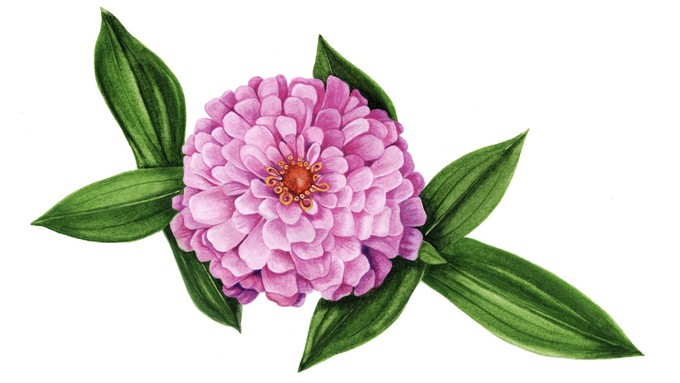
In a national webinar, BBC’s Advolly Richmond shares backstories of our favorite plants

The beautiful floral illustrations in Advolly Richmond's new book are by Sarah Jane Humphrey. Illustration by Sarah Jane Humphrey, courtesy “A Short History of Flowers” (Frances Lincoln)
Here’s an opportunity to immerse yourself in garden knowledge – and still beat the heat: A virtual (and beautiful) history lesson on the origins of our favorite flowers.

Set for 11 a.m. PDT on Thursday, Aug. 8, “A Short History of Flowers: The Stories That Make Our Gardens” traces how many ornamental plants found a home in our landscapes and our hearts. Garden and social historian Advolly Richmond of BBC’s “Gardeners’ World” will share some of her favorites (both plants and stories) from her new book, “A Short History of Flowers,” illustrated by Sarah Jane Humphrey.
To be held via Zoom, the one-hour online presentation is part of The Garden Conservancy’s series of Virtual Programs. Advance registration ($15) is required. Find the link here: https://www.gardenconservancy.org/education/education-events/virtual-talk-a-short-history-of-flowers.
(Unavailable to sit in on the live Zoom? A recording of the webinar will be sent to all registrants a few days after the event. The Garden Conservancy encourages interested folks to register, even if they cannot attend the live webinar.)
The author, podcaster and TV presenter will take participants around the world and back through time on a journey full of flowers – and wild adventures.
“Advolly Richmond’s beautifully illustrated talk highlights some of the flowers featured in her book, ‘A Short History of Flowers,’ ” say the organizers. “Many of the plants we love and grow as ornamentals first appeared in early herbals for medicinal and culinary use. But how often do we stop to think about how these beautiful flowers ended up in our tiny corner of the world?
“Flowers have played pivotal roles in societies for centuries, from the wild fuchsia hedgerows of Ireland, to the lily of the valley bringing luck and making a bold fashion statement in Paris. All of these blooms hold a treasure trove of stories,” they add.
“Have a giggle, shed a tear, but most of all, enjoy the tales of exploration in disguise, enduring love, cultural appropriation, and hybridization that Advolly will bring to life in this webinar. You will also get a glimpse of some of the gorgeous, specially commissioned botanical illustrations which appear in the book.”
Based in England, Richmond is best known to Americans for her work on BBC’s “Gardeners’ World.” Producer of “The Garden History Podcast,” she adds history and context to BBC garden features as well as contributes plant history profiles on BBC Radio 4. Her new book, “A Short History of Flowers” (published by Frances Lincoln, 208 pages, March 2024, $24.99 hardcover), features 60 plants and their backstories – full of intrigue and surprising twists.
As in the book, the flower stories will be accompanied in Thursday’s presentation by gorgeous illustrations. It’s a thought-provoking way to enjoy some serious (and light-hearted) gardening on a 100-degree day.
For more on The Garden Conservancy and its programs: https://www.gardenconservancy.org/.
Comments
0 comments have been posted.Sacramento Digs Gardening to your inbox.
Food in My Back Yard Series
April 1: Don't be fooled by these garden myths
March 25: Fertilizer tips: How to 'feed' your vegetables for healthy growth
March 18: Time to give vegetable seedlings some more space
March 11: Ways to win the fight against weeds
March 4: Potatoes from the garden
Feb. 25: Plant a fruit tree now -- for later
Feb. 18: How to squeeze more food into less space
Feb. 11: When to plant? Consider staggering your transplants
Feb. 4: Starting in seed starting
Sites We Like
Garden Checklist for week of March 30
Your garden doesn’t mind April showers. Get busy now to enjoy those future flowers.
* Get ready to swing into action in the vegetable garden. As nights warm up over 50 degrees, start setting out tomato, pepper and eggplant transplants.
* From seed, plant beans, beets, cantaloupes, carrots, corn, cucumbers, melons, pumpkins, radishes and squash. (Soak beet seeds overnight in water for better germination,)
* Plant onion sets.
* In the flower garden, plant seeds for asters, cosmos, celosia, marigolds, salvia, sunflowers and zinnias.
* Transplant petunias, zinnias, geraniums and other summer bloomers.
* Plant perennials and dahlia tubers for summer bloom.
* Transplant lettuce and cabbage seedlings.
* April is the last chance to plant citrus trees such as dwarf orange, lemon and kumquat. These trees also look good in landscaping and provide fresh fruit in winter.
* Smell orange blossoms? Feed citrus trees with a low dose of balanced fertilizer (such as 10-10-10) during bloom to help set fruit. Keep an eye out for ants.
* Apply slow-release fertilizer to the lawn.